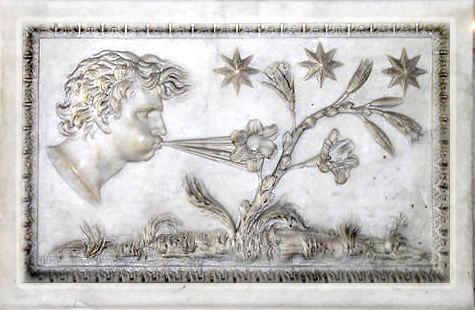 | ||
Zerreißet, zersprenget, zertrümmert die Gruft (Destroy, burst, shatter the tomb), BWV 205 is a secular cantata by Johann Sebastian Bach.
Contents
History and text
The cantata was commissioned by the students of Leipzig University for the popular professor August Friedrich Müller and premiered on his name day on 3 August 1725 as a dramma per musica under the title Der zufriedengestellte Aeolus (The contented Aeolus).
Its libretto was written by Christian Friedrich Henrici and begins with Pallas Athene (sung by a soprano) setting up a celebration in honour of Müller. However, she fears that Aeolus (bass) could ruin the celebrations with heavy storms in August. With the help of Zephyrus (tenor) the god of mild winds and Pomona the goddess of fruitfulness (alto), Pallas manages to appease Aeolus and those present grant a vivat in unison for the professor.
Bach wrote other works for university occasions: the cantata is one of twelve surviving Festmusiken zu Leipziger Universitätsfeiern, that is music for festivals of Leipzig University.
Scoring and structure
The cantata is scored for four solo voices – Pallas as soprano, Pomona as alto, Zephyrus as tenor, and Aeolus as bass – a four-part choir, three trumpets, timpani, two horns, two flutes, two oboes, oboe d'amore, two violins, viola, viola d'amore, viola da gamba, and basso continuo.
The piece has fifteen movements:
- Chorus: Zerreißet, zersprenget, zertrümmert die Gruft
- Recitative (bass): Ja! ja! Die Stunden sind nunmehro nah
- Aria (bass): Wie will ich lustig lachen
- Recitative (tenor): Gefürcht'ter Aeolus
- Aria (tenor): Frische Schatten, meine Freude
- Recitative (bass): Beinahe wirst du mich bewegen
- Aria (alto): Können nicht die roten Wangen
- Duet recitative (alto and soprano): So willst du, grimmger Aeolus
- Aria (soprano): Angenehmer Zephyrus
- Duet recitative (soprano and bass): Mein Aeolus
- Aria (bass): Zurücke, zurücke, geflügelten Winde
- Trio recitative (soprano, alto, tenor): Was Lust!
- Duet aria (alto and tenor): Zweig und Äste
- Recitative (soprano): Ja, ja! ich lad euch selbst zu dieser Feier ein
- Chorus: Vivat August
